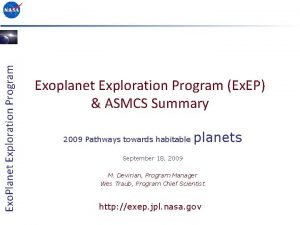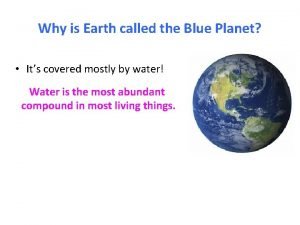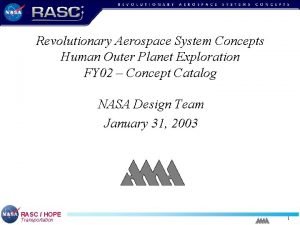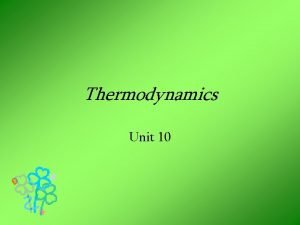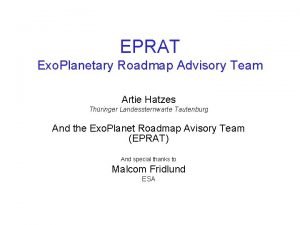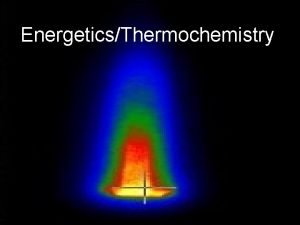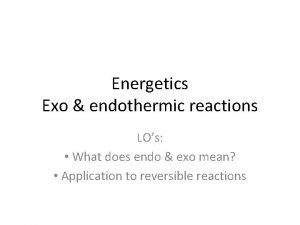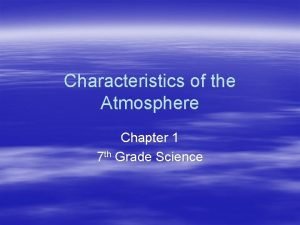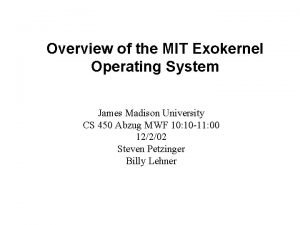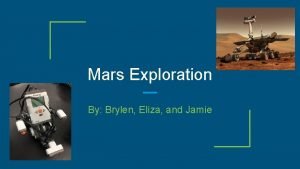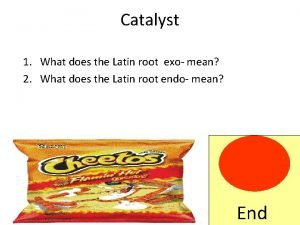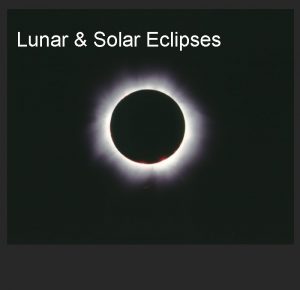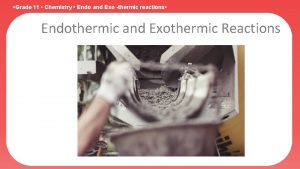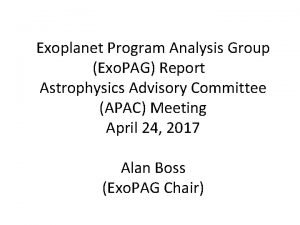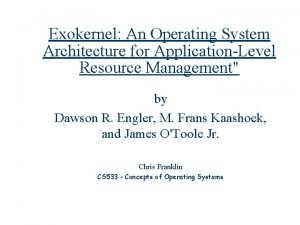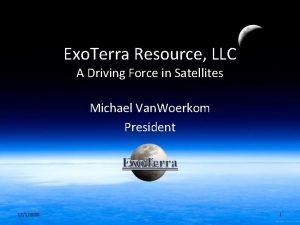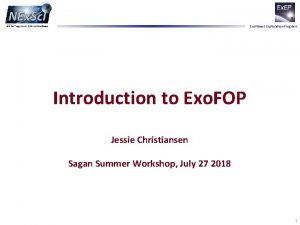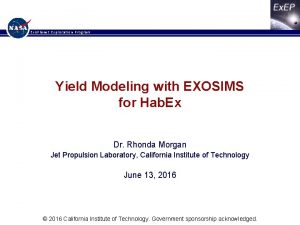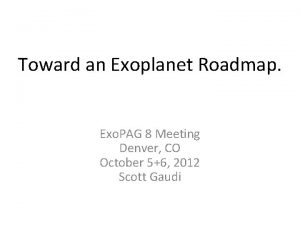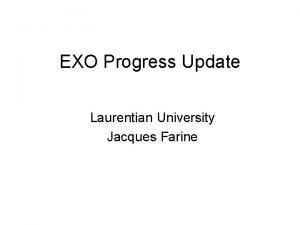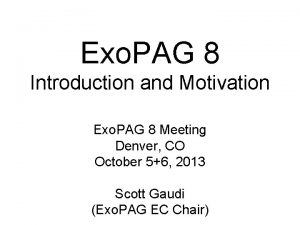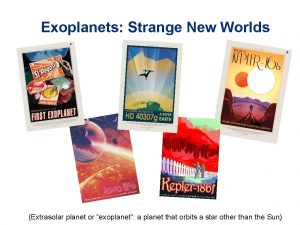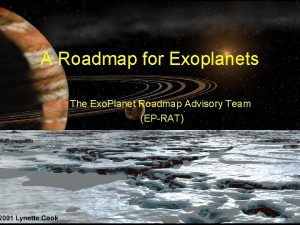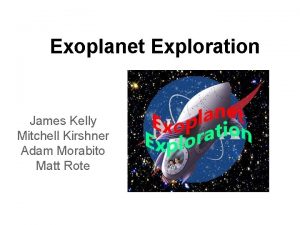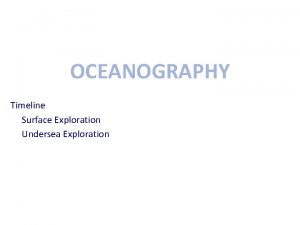Exo Planet Exploration Program Exoplanet Exploration Program Ex

















- Slides: 17

Exo. Planet Exploration Program Exoplanet Exploration Program (Ex. EP) & ASMCS Summary 2009 Pathways towards habitable planets September 18, 2009 M. Devirian, Program Manager Wes Traub, Program Chief Scientist http: //exep. jpl. nasa. gov

Exoplanet Exploration Program (Ex. EP) – Navigator Program Renamed & Rescoped Navigator Program Prime Objective Exo. Planet Exploration Program • Large mission concepts (TPF-C/I/O, etc. ) are long range targets for technology development • Near-term focus on medium strategic missions with competed science – 2012 earliest call • SIM-Lite in formulation under review by Astro 2010, NRC Decadal Survey – Mike Shao, Project Scientist • Kepler moves into Ex. EP post-commissioning – Bill Borucki, Science PI • NASA Exoplanet Science Institute (NEx. Sc. I) (formerly Michelson Science Center) – Chas Beichman, Executive Director September 18, 2009 Pathways towards habitable planets - M. Devirian 2

Additional Ex. EP elements Exo. Planet Exploration Program • New: Exoplanet Supporting Research & Technology – – – NEx. Sc. I science activities (data access/archives, fellowships, etc) Technology for Advanced Strategic Mission Concept Studies 08 -09 Technology testbed support competed technology efforts starting 2010 Peter Lawson, Science & Technology Architect for Ex. EP Marie Levine, Technology Infrastructure Manager • Ground Observatories: – Keck Interferometer completing selected key science (exozodi) • Rachel Akeson, Project Scientist – Future time through NASA Keck TAC (77 proposals for 2010 A) – LBTI instrument to be completed; key science operation after LBTO on sky • Phil Hinz, PI • On-going community engagement: – Exoplanet Science Forum and Exoplanet Program Analysis Group (Exo. PAG) – Jim Kasting, Chairman September 18, 2009 Pathways towards habitable planets - M. Devirian 3

SR&T – Science Support • NASA Exoplanet Science Institute Exo. Planet Exploration Program (NEx. Sc. I – former Michelson Science Center) – Sagan Program: 5 new post-doctoral fellows and a summer workshop each year. – Allocate NASA/Keck time and PI data awards – Support/host Exoplanet-related conferences and workshops. – Science Tools & Operations • Keck Observatory – Keck Interferometer – Archive: HIRES & NIRSPEC Michelson Summer Workshop Class of 2007 • Kepler Science Analysis System • NASA Star and Exoplanet Database (NSTED) Leadership: • US Data Node for Co. Ro. T Mission Charles Beichman Executive Director • SIM-Lite or future Exo. Planet Mission Shri Kulkarni Science Director Rachel Akeson David A. Imel September 18, 2009 Pathways towards habitable planets - M. Devirian Deputy Director Project Manager 4

SR&T – Technology Program Exo. Planet Exploration Program • Technology program started under TPF – to enable the future – Achieved near-flight-level performance in key starlight suppression technologies: both VIS (coronagraphs) and IR (nulling interferometers) – Achieved significant milestones in precision formation flying for IR interferometer (TPF-I/Darwin) – Support to ASMCS PIs in 2008 -9 to advance concept maturity – Results from program referenced in a number of papers in this conference • Forward plan provides for broad combined effort – Program-developed testbeds & directed technology – Competed participation including non-NASA and NASA PIs through Technology Demonstrations for Exoplanet Missions (TDEM) call • • September 18, 2009 5 – 10 new awards per year ~$5 M over 2 years for each solicitation Coordination website: http: //exep. jpl. nasa. gov/exep_roses 09. cfm First round of proposals submitted, fund January 2010 2009 Pathways towards habitable planets - M. Devirian 5

Exo. Planet Exploration Program Coming Opportunities to Participate • Sagan Fellowship applications November 2009 • Kepler GO Proposals due January 2010 • Double-blind imaging study teams • Medium Strategic Mission Science Solicitation – 2012 expected September 18, 2009 Pathways towards habitable planets - M. Devirian 6

Ex. EP Level 1 Schedule Exo. Planet Exploration Program Annual Technology call Keck calls (only 2009 shown) LBTI on the horizon Notional future mission schedule September 18, 2009 Pathways towards habitable planets - M. Devirian 7

Summary of ASMCS Special Session Probes (<$1 B) Flagships (>$1 B) Exo. Planet Exploration Program Actively-Corrected Coronagraph for Exoplanet System Studies; PI: John Trauger (JPL) Probe class Dilute Aperture Visible Nulling Coronagraph Imager PI: Michael Shao (JPL) Flagship class New Worlds Observer; PI: Webster Cash (U of Colorado) Flagship class Extrasolar Planetary Imaging Coronagraph; PI: Mark Clampin (NASA GSFC) Probe class THEIA: Telescope for Habitable Exoplanets and Interstellar/ Intergalactic Astronomyr; PI: David Spergel (Princeton) Flagship Pupil-Mapping Exoplanet Coronagraphic Observer PI: Olivier Guyon (U of Arizona) Probe class Advanced Technology Large-Aperture Spce Telescope (ATLAST); PI: Marc Postman (STSc. I) Flagship class Planet Hunter; PI: Geoff Marcy (UC Berkeley) Probe class September 18, 2009 CREDIT: STSc. I & NGST 2009 Pathways towards habitable planets - M. Devirian 8

Flagship THEIA: Telescope for Habitable Exoplanets and Intergalactic/Galactic Astronomy • 4 meter, on-axis telescope • 5 year nominal mission length + 5 year extended • Fit onto Atlas V launch Vehicle (two launch vehicles for telescope and occulter) • Existing spacecraft hardware Uses a 40 m external occulter operating at two distances for two wavelength bands for planet detection and characterization Science Instruments • • • e. Xo. Planet Characterizer (XPC) Detect Earthlike Planets in Habitable Zone Characterize from 250 -1000 nm Star Formation Camera (SFC) Census of Star Forming Regions Survey nearby galaxies from 190 -1075 nm Panchromatic survey of cosmological Targets Ultra. Violet Spectrograph (UVS) Cosmic web spectroscopy At η⊕=1, THEIA detects over 30 Earth-like planets Galactic Interfaces THEIA characterizes almost 20 of them over the full spectral band, getting Ozone, Oxygen, Star Formation CO 2 and Water Planetary Transits THEIA has enough repeat detections on five of them to characterize their orbits • • Because of the multiple distances, THEIA saves enough fuel to go an extra 5 years

Flagship The New Worlds Observer W. Cash, University of Colorado, PI • An External Occulter about 50 m in diameter is flown 80, 000 km from telescope along line of sight to star. Starlight is suppressed, but planet light passes unimpeded as close as 60 mas from the star. • Study showed Starshades can be implemented quickly and are affordable. Starshade Concept works with any telescope – including JWST Simulation of Solar System Imaged with JWST 10 September 18, 2009 Simulation of Earth spectrum taken with large UVOIR observatory

Flagship Advanced Technology Large. Aperture Space Telescope 8 -m 9 -m Reflectivity #FGK Stars Observable in <500 ksec UVOIR Flagship Mission for the 2025 Era ATLAST has the sensitivity and the angular resolution to characterize ~100 or more Potentially Habitable Worlds in 5 years: • IWA < 60 mas at 500 nm, • 10 -sigma limit: <0. 6 n. Jy in 100 ksec @ R=5 • SNR=100 spectra of O 2 features in <100 ksec Telescope Aperture Multiple architectures explored, capable of using multiple starlight suppression methods. Enables breakthroughs in both exoplanet and general astrophysics research. Earth R=500 Spectra of Earth Twin with ATLAST Wavelength (microns) ATLAST Starshade Sim

Flagship Dilute Aperture Visible Nulling Coronagraphic Imager (DAVi. NCI), M. Shao Science of an 8 m coronagraph at the cost of a 2. 5 m telescope, (Team. X cost 1. 2 B) DAVi. NCI IWA = 38 mas @800 nm, (Equiv 8 m @ 2 l/D) 0. 5 um to 1. 7 um converage (25%BW at a time) Segmented MEMs DM, amp/phase control Search up to ~150 stars for Earths @1 AU Can measure orbits of planets, with images of the exoplanetary system at many (10~20 epochs, not just once), measure, not just guess that the planet is in the HZ. Nulling coronagraph architecture compatible © 2008 California Institute of Technology. Government sponsorship acknowledged. with, filled, segmented and dilute apertures.

Probe September 18, 2009 Pathways towards habitable planets - M. Devirian 13

Probe Extra. Solar Imaging Planetary Coronagraph (EPIC) l EPIC will image and characterize extrasolar giant planets and their environments Simulated VNC Image: Our solar system viewed at 10 pc EPIC’s discovery space is enabled by its ≤ 2λ/D inner working angle: ~55 RV planets would be available for detection and characterization l ASMC Study: - Science case, planets within IWA, dust disks - Systems level understanding - EPIC/VNC modeling & performance assesment - VNC STOP analysis & wavefront control - Costing at GSFC IDC & JPL Team-X September 18, 2009 Pathways towards habitable planets - M. Devirian 14

PECO Pupil mapping Exoplanet Coronagraph Observer Univ. of Arizona Ames Research Center • • • Pupil mapping Exoplanet Coronagraphic Observer (PECO) Probe 1. 4 -m diameter off-axis telescope, 3 yr mission drift-away heliocentric orbit for maximum stability High efficiency wavefront control to maintain high contrast 0. 4 – 0. 9 micron spectral coverage / R~20, polarimetric imaging Instrument & coronagraph are optimized for maximum sensitivity PECO instrument design also applicable to larger telescope diameters. PECO Technology PECO Science Simulation of 24 hr of PECO data showing an Earth-like planet (a=0. 2) around Tau Ceti with 1 zodi of exododi dust in a uniform density disk inclined 59 degrees. This is a simulation of λ= 550 nm light in a 100 nm bandpass PECO (1. 4 m aperture). Photon noise and 16 electrons total detector noise for an electron multiplying CCD have been added. Lossless apodization (PIAA) with aspheric optics allows 2 l/D inner working angle with full throughput, making optimal use of PECO’s 1. 4 m diameter telescope September 18, 2009 Habitable planets PECO can detect Super-Earths in the habitable zone of the 22 most favorable stars, and Earths for the 9 most favorable targets (SNR=5 at R=5 in <12 h exposure) Exo-zodi mapping PECO has sub-zodi sensitivity in the habitable zone of >20 stars Giant planets High SNR R=20 spectroscopy and polarimetry More info on PECO: http: //caao. as. arizona. edu/PECO/ 2009 Pathways towards habitable planets - M. Devirian 15

Exo. Planet Exploration Program Manager’s observations • TPF–C and Darwin/TPF–I also remain viable flagship candidates. • Many additional (arguably) Probe-class concepts (THESIS, FKSI, TRESS, ASTr. O, Occulter for JWST, …). • No obvious “best” architecture for near-term Probe (capability vs. risk). – Many good ones – Some nearly ready (TRL 5 -6) • “Quick model-based costing” for novel architectures is unreliable; deep-penetration cost estimation requires significant resources and expertise; this poses risk for agency planning. • Exoplanets must be an international effort. September 18, 2009 Pathways towards habitable planets - M. Devirian 16

Exo. Planet Exploration Program THANK YOU To the local organizers and Barcelona supporters for a wonderfully organized scientific conference! http: //exep. jpl. nasa. gov NASA’s Exoplanet Exploration Program September 18, 2009 Pathways towards habitable planets - M. Devirian 17
 Exoplanet exploration program
Exoplanet exploration program Why is earth called the blue planet?
Why is earth called the blue planet? Vasimr
Vasimr Endo vs exothermic graphs
Endo vs exothermic graphs Sufijo gonia
Sufijo gonia Exo advisory group
Exo advisory group How to determine exothermic or endothermic
How to determine exothermic or endothermic Enthalpy exo or endo
Enthalpy exo or endo Tropo strato meso thermo exo
Tropo strato meso thermo exo Exokernel operating system
Exokernel operating system Exo moskwy
Exo moskwy Exo latin root
Exo latin root Wilkinson exo
Wilkinson exo Lunar eclipse meaning
Lunar eclipse meaning Thermic reactions
Thermic reactions Exo advisory group
Exo advisory group Exo kernel
Exo kernel Exo terra resource
Exo terra resource
